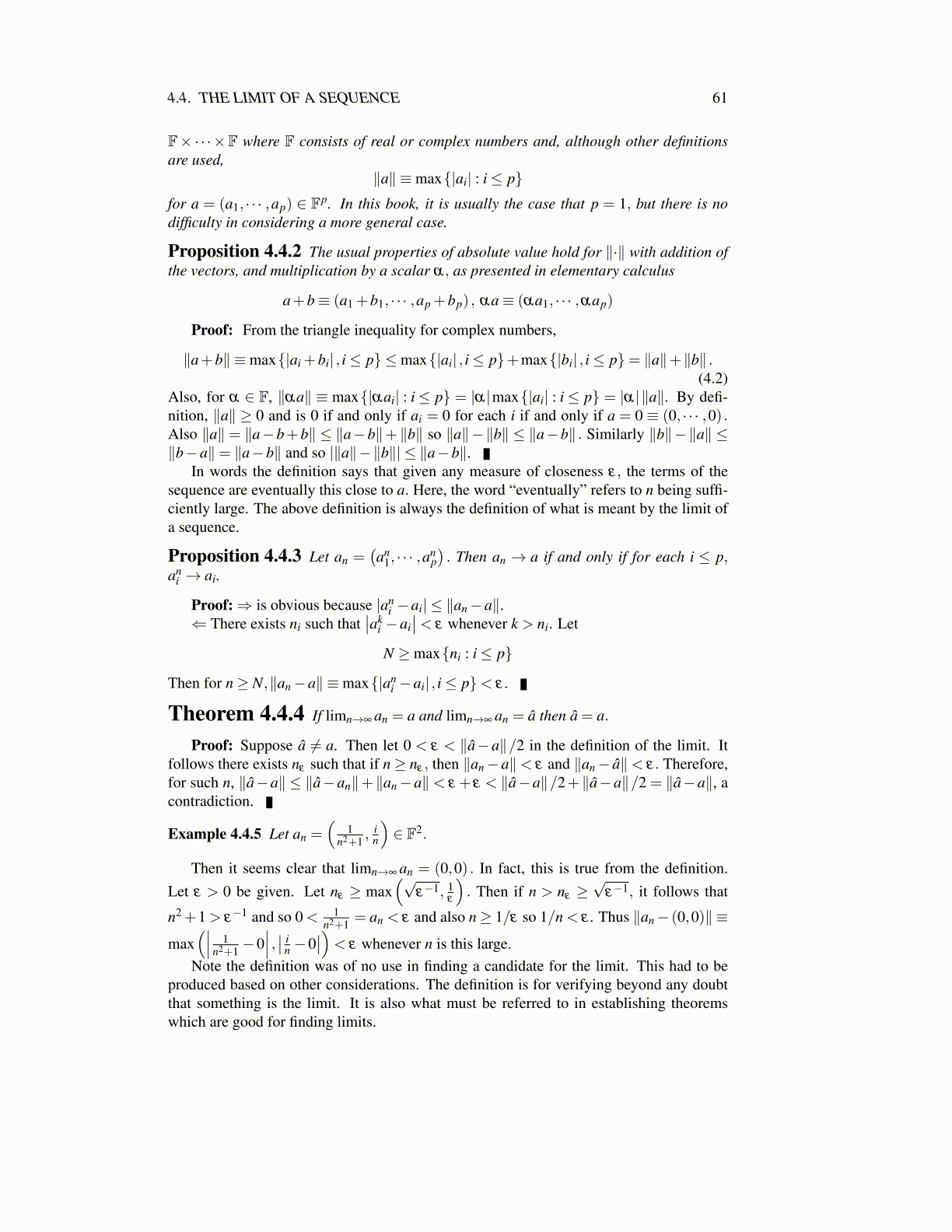
4.4. THE LIMIT OF A SEQUENCE 61
≤ 2|b|∥an−a∥+ 2∥a∥
|b|2|∥bn−b∥| .
Now choose n2 so large that if n≥ n2, then
∥an−a∥< ε |b|4
, and |bn−b|< ε |b|2
4(∥a∥+1).
Letting nε > max(n1,n2) , it follows that for n≥ nε ,∥∥∥∥an
bn− a
b
∥∥∥∥≤ 2|b|∥an−a∥+ 2∥a∥
|b|2|bn−b|< 2
|b|ε |b|
4+
2∥a∥|b|2
ε |b|2
4(∥a∥+1)< ε.
Another very useful theorem for finding limits is the squeezing theorem.
Theorem 4.4.9 In case an,bn ∈ R, suppose limn→∞ an = a = limn→∞ bn and an ≤cn ≤ bn for all n large enough. Then limn→∞ cn = a.
Proof: Let ε > 0 be given and let n1 be large enough that if n≥ n1, |an−a|< ε/2 and|bn−a|< ε/2. Then for such n,|cn−a| ≤ |an−a|+ |bn−a|< ε. The reason for this is thatif cn ≥ a, then |cn−a|= cn−a≤ bn−a≤ |an−a|+ |bn−a| because bn ≥ cn. On the otherhand, if cn ≤ a, then
|cn−a|= a− cn ≤ a−an ≤ |a−an|+ |b−bn| .
As an example, consider the following.
Example 4.4.10 Let cn ≡ (−1)n 1n and let bn =
1n , and an =− 1
n . Then you may easily showthat limn→∞ an = limn→∞ bn = 0. Since an ≤ cn ≤ bn, it follows limn→∞ cn = 0 also.
Theorem 4.4.11 limn→∞ rn = 0. Whenever |r|< 1. Here r ∈ F.
Proof: If 0 < r < 1 if follows r−1 > 1. Why? Letting α = 1r − 1, it follows r = 1
1+α.
Therefore, by the binomial theorem, 0 < rn = 1(1+α)n ≤ 1
1+αn . Therefore, limn→∞ rn = 0 if0 < r < 1. In general, if |r|< 1, |rn|= |r|n→ 0 by the first part.
An important theorem is the one which states that if a sequence converges, so doesevery subsequence. You should review Definition 4.2.4 on Page 56 at this point.
Theorem 4.4.12 Let {xn} be a sequence with limn→∞ xn = x and let{
xnk
}be a
subsequence. Then limk→∞ xnk = x.
Proof: Let ε > 0 be given. Then there exists nε such that if n > nε , then ∥xn− x∥< ε.Suppose k > nε . Then nk ≥ k > nε and so
∥∥xnk − x∥∥< ε showing limk→∞ xnk = x as claimed.
Theorem 4.4.13 Let {xn} be a sequence of real numbers and suppose each xn ≤ l(≥ l) for all n large enough, and limn→∞ xn = x. Then x≤ l (≥ l) . More generally, suppose{xn} and {yn} are two sequences of real numbers such that limn→∞ xn = x and limn→∞ yn =y. Then if xn ≤ yn for all n sufficiently large, then x≤ y.